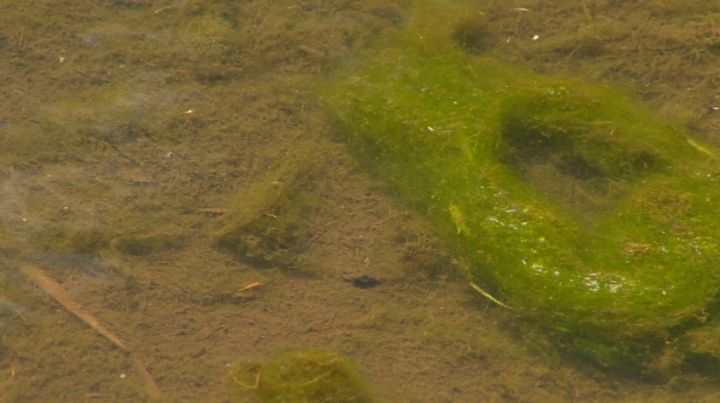As the temperature begins to rise in New Brunswick, blue-green algae can be formed in rivers and lakes, producing toxins that can be harmful to people and their pets.

“We want all residents to be active and enjoy the outdoors but we also want them to understand and consider the potential risks of exposure to blue-green algae,” said Dr. Jennifer Russell, chief medical officer of health.
Blue-green algae are a natural component of New Brunswick’s aquatic ecosystems but, according to a press release from the government, the algae can increase in numbers under certain conditions to form blooms, which can appear blue-green, green, red, brown or yellow in colour.
READ MORE: Toxic blue-green algae killed three N.B. dogs, health officials say
Not all blooms are harmful, but some blue-green algae can produce toxins, which can cause skin, eye and throat irritation. More serious health effects such as gastrointestinal illness can occur if toxins are consumed. Toxins can also be harmful to fish, wildlife, livestock and domestic animals.
“While enjoying any recreational water, there are always things you can do to help protect yourself,” said Russell.

Get weekly health news
“Algae blooms can be unpredictable so it is important that people always check the water before entering. If a bloom is present, it is recommended that you avoid swimming or engaging in other activities that may involve contact with the water,” she added.
To stay safe, Russell advises people to always supervise young children and pets in recreational waters, wash hands before eating, not swallow lake or river water and bathe or shower immediately after swimming.
“Do not enter the water with open cuts or sores,” Russell said.
WATCH: Blue-green algae, which can be detrimental to the health of humans and animals, is growing in many Kingston-area lakes

The government is also advising pet owners that algae mats along the shore of lakes and rivers can be toxic and particularly harmful to dogs. Algae mats look like clumps of vegetation and can appear black, brown or dark green in the water.
“They can be attached to rocks or aquatic vegetation or may be floating in the water. On the shoreline, they may appear brown or grey once they have dried. Dogs are attracted to their odour and should not be permitted to eat vegetation or floating mats, as they can be lethal if consumed,” the press release explains.
According to the government, there are various blue-green algae research projects underway in the Saint John River and several lakes in the province through the Environmental Trust Fund.
The projects are intended to build a better understanding of the distribution of blue-green algae and their toxins.
- ‘Deeply ashamed’: Canadian Medical Association apologizes for harms to Indigenous peoples
- Kate Middleton marks quiet return to work following cancer treatment
- Health Canada gives 1 year to remove BVO from drinks. What are the risks?
- Never heard of eastern equine encephalitis? Cases are ‘likely underreported’








Comments